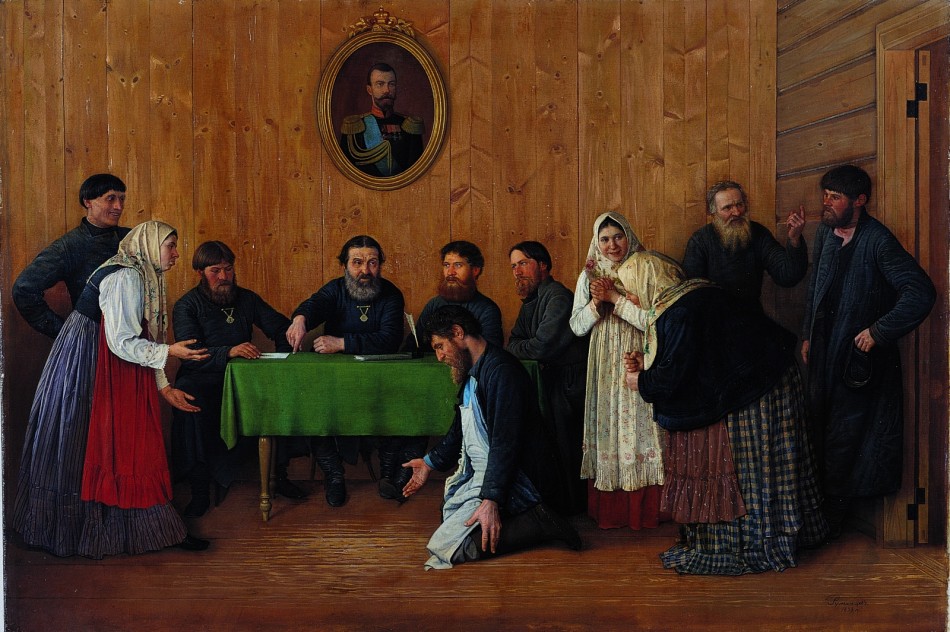
Is That a Bid, Comrade?
TEFAF – The Russians Are Coming …and Buying
Maastricht (Netherlands) – If art follows capital, then much of it is headed toward the former epicenter of international communism, Russia. In the art market, the sons of Lenin are racing to keep up with the heirs of Mao. Russia is a crucial component of the fast-growing BRIC nations – Brazil, Russia, India, China – who are helping fuel a surge in prices.

Is That a Bid, Comrade?
The European Fine Art Fair (TEFAF) may have been courting the Chinese this year, but the new design of its entrance suggested that the fair was ready for Russians, as well. In a black and white scheme, a huge glass chandelier made it seem as if you were entering Las Vegas on the Volga. Further along, a monumental white circle could have been a projection of an abstraction by Kasimir Malevich, who was punished for defying official stylistic guidelines. The Russians are buying those pictures back these days, when the works come up for sale. (A number of them at the Stedelijk Museum in Amsterdam, which opens soon, have been the subject of an ownership dispute.)
In the late 1920’s, when Stalin was short of cash, he sold masterpieces from the State Hermitage Museum, some to Andrew Mellon, the prototype for the stripe-trousered top-hatted plutocrat at the twilight of the robber baron era, which most of us call the Great Depression. Mellon was also the US Treasury Secretary from 1921 to 1932.
Today you can’t buy works by van Dyck and Vermeer that are now in western museums, but the Mellons of the New Russia and other territories of the former Soviet Union are buying in volume, and Russian 19th century paintings are a field of choice.

Blessed is this Vodka, and Expensive
You could sample those Russian pictures in Maastricht at the booth of the Montgomery Gallery of San Francisco, where works from the estate of an America collector going through a divorce were for sale.
A painting that Peter Fairbanks of Montgomery expected to bring $2 million was L’Elegante aux Orchidees, a full length portrait by Konstantin Egorovich Makovsky.

Konstantin Egorovich Makovsky - The Artist's Wife in Orchids
(Russian, 1839-1915) of his wife, in a gown decorated with elaborate floral patterns. Russia’s John Singer Sargent (some might say James Tissot) painted it in 1900.

Boom and Bust - Insiders say Russian Buyers Can Weather It All
It was hard to miss a figure that was clothed in a lot less. Negresse by Nicolai Konstantinovich Kalmakov (aka Nicolas Kalmakoff,1873-1955) was a Russian take on 19th century French orientalist exoticism, but with a pose that was much more defiant. The perfect gift for a self-confident billionaire? This one was selling in the low six figures, but it had sold for a lot less five years ago.
Not coming from Russia, I couldn’t tell if what I was viewing was intended to be humorous, but I wasn’t the only one grinning at Consecration of a State Dram Shop (The Blessing of the Vodka Shop) by Nicholai Vasilievich Orlov, from 1904. In a room with a wooden floor and a low ceiling, a priest was blessing the store that sold spirits, and a small well-dressed group was waiting with varying expressions of anticipation. On another wall, a battle scene depicted central Asian competing on horseback, Circassians Celebrating the end of Muharram with the Equestrian Sport of the Dash for the Prize Lamb (1889), by Frantz Roubaud (1856-1928). “Is that a Remington?” asked an American critic after a quick glance from a distance. If you were Russian it was.

If This Looks Rough, Try an Auction
No word on how much was sold at the Montgomery booth. But specialists in this market warn against viewing Russian buyers as inexperienced and willing to pay extortionate prices for anything that makes them think of Mother Russia. A decade ago, th conventional wisdom was that the Russian buyer bloated with money was a mix of The Possessed and The Idiot.
“Today Russian collectors are collecting very knowledgably, said Sandra Nedvetskaia, who oversees Russian business at Christie’s in Zurich. “They are very savvy buyers and the Russian-speaking buyers are buying across the board.”
It’s not a question of Russians out to repatriate their culture at any price, she stresse, and they are buying more than their own artists. Let’s not forget that Francis Bacon’s highest auction price came in May 2008 when the London-based oligarch collector Roman Abramovich bought his Triptych, 1976, for $83.6m.
Only about half of the art that Russians buy abroad (and that includes Russian-speaking buyers from throughout the former Soviet Union) goes back to Russia. Tax laws are burdensome and complicated, insiders say. Theft is also a risk.
But the volume of art returning to Russia and being imported there is on the rise, said Nedvetskaia. “More and more, collectors actually want to live with their objects.”
After the crisis of 2008, which displaced many Americans from the market for a while, “the Russian buyers stayed in the market for the most part – there were several casualties, but very few, compared to the American buyers,” she said.
“Boom and bust has happened so many times in Russia over the past 20 years that people are extremely savvy in dealing with their investments and their funds,” she noted.
